DTC P0A94-553 DC / DC Converter Performance |
| DTC No. | INF Code | DTC Detection Condition | Trouble Area |
| P0A94 | 553 | Boost converter fail signal detection (boost converter overheating) |
|
| 1.CHECK DTC OUTPUT (HV) |
Connect the intelligent tester to the DLC3.
Turn the power switch on (IG).
Enter the following menus: Powertrain / Hybrid Control / Trouble Codes.
Check if DTCs are output.
| Result | Proceed to |
| DTC P0A94-553 only is output. | A |
| Any of the following DTCs are also output. | B |
| DTC No. | Relevant Diagnosis |
| P0A1A (all INF codes)*1 | Generator Control Module |
| P0A1B (all INF codes)*1 | Drive Motor "A" Control Module |
| P0A1D (all INF codes)*1 | Hybrid Powertrain Control Module |
| P0A3F-243 | Drive Motor "A" Position Sensor Circuit |
| P0A40-500 | Drive Motor "A" Position Sensor Circuit Range / Performance |
| P0A41-245 | Drive Motor "A" Position Sensor Circuit Low |
| P0A4B-253 | Generator Position Sensor Circuit |
| P0A4C-513 | Generator Position Sensor Circuit Range / Performance |
| P0A4D-255 | Generator Position Sensor Circuit Low |
| P0A60 (all INF codes)*1 | Drive Motor "A" Phase V Current |
| P0A63 (all INF codes)*1 | Drive Motor "A" Phase W Current |
| P0A72 (all INF codes)*1 | Generator Phase V Current |
| P0A75 (all INF codes)*1 | Generator Phase W Current |
| P0A78-113, 128, 266, 267, 279, 284, 286, 287, 306, 503, 504, 505, 506, 586, 806, 807, 808 | Drive Motor "A" Inverter Performance |
| P0A7A-122, 130, 322, 324, 325, 344, 517, 518, 809, 810, 811 | Generator Inverter Performance |
| P0A90-509 | Drive Motor "A" Performance |
| P0A92-521 | Hybrid Generator Performance |
| P0A94-442, 547, 548, 549, 554, 555, 556, 585, 587, 589, 590 | DC / DC Converter Performance |
| P0C73-776 | Motor Electronics Coolant Pump "A" Control Performance |
| P0C76-523 | Hybrid Battery System Discharge Time Too Long |
| P314A-828 | Inverter Coolant Pump Speed Signal |
Turn the power switch off.
|
| ||||
| A | |
| 2.CHECK CONNECTOR CONNECTION CONDITION (INVERTER WITH CONVERTER ASSEMBLY CONNECTOR) |
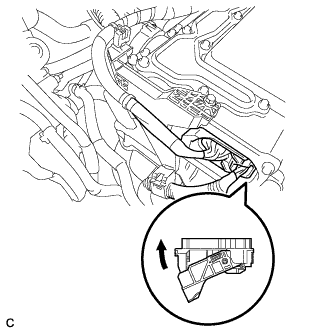 |
Check that the service plug grip is not installed.
Check the connection of the low voltage connector of the inverter with converter assembly.
|
| ||||
| OK | |
| 3.CHECK QUANTITY OF HV COOLANT |
Check the coolant level in the inverter reserve tank.
Check for coolant leaks.
| Result | Proceed to |
| No leaks are found and coolant level in the inverter reserve tank assembly is above the low line. | A |
| No leaks are found and coolant level in the inverter reserve tank assembly is below the low line. | B |
| Coolant leaks are evident. | C |
|
| ||||
|
| ||||
| A | |
| 4.CHECK COOLANT HOSE |
Check if the hoses of the cooling system are kinked or clogged.
|
| ||||
| OK | |
| 5.PERFORM ACTIVE TEST USING INTELLIGENT TESTER (CONTROL THE ELECTRIC COOLING FAN) |
Connect the intelligent tester to the DLC3.
Turn the power switch on (IG).
Enter the following menus: Powertrain / Hybrid Control / Trouble Codes.
Clear DTCs and freeze frame data.
Enter the following menus: Powertrain / Engine and ECT / Active Test / Control the Electric Cooling Fan.
Perform the "Control the Electric Cooling Fan" Active Test.
Turn the power switch off.
|
| ||||
| OK | |
| 6.CHECK HV COOLANT (CHECK FOR CONDITIONS THAT MAY HAVE CAUSED FREEZING) |
Connect the intelligent tester to the DLC3.
Turn the power switch on (IG).
Read the freeze frame data Ambient Temperature using the intelligent tester.
Check if the freeze frame data Ambient Temperature is below freezing.
| Result | Proceed to |
| Ambient Temperature value is above freezing temperature of the HV coolant | A |
| Ambient Temperature value is below freezing temperature of the HV coolant | B |
Turn the power switch off.
|
| ||||
| A | |
| 7.CHECK HARNESS AND CONNECTOR (INVERTER WITH CONVERTER ASSEMBLY - GENERATOR RESOLVER) |
Disconnect the low voltage connector D29 from the inverter with converter assembly.
Turn the power switch on (IG).
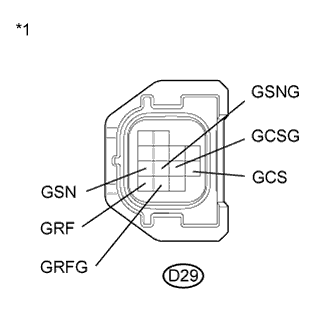 |
Measure the voltage according to the value(s) in the table below.
| Tester Connection | Switch Condition | Specified Condition |
| D29-11 (GRF) - Body ground | Power switch on (IG) | Below 1 V |
| D29-12 (GRFG) - Body ground | Power switch on (IG) | Below 1 V |
| D29-7 (GSN) - Body ground | Power switch on (IG) | Below 1 V |
| D29-8 (GSNG) - Body ground | Power switch on (IG) | Below 1 V |
| D29-10 (GCS) - Body ground | Power switch on (IG) | Below 1 V |
| D29-9 (GCSG) - Body ground | Power switch on (IG) | Below 1 V |
| *1 | Front view of wire harness connector (to Inverter with Converter Assembly) |
Turn the power switch off.
Connect the low voltage connector from the inverter with converter assembly.
|
| ||||
| OK | |
| 8.CHECK GENERATOR RESOLVER |
Disconnect the low voltage connector D29 from the inverter with converter assembly.
 |
Measure the resistance according to the value(s) in the table below.
| Tester Connection | Switch Condition | Specified Condition |
| D29-11 (GRF) - D29-12 (GRFG) | Power switch off | 7.1 to 21.6 Ω |
| D29-7 (GSN) - D29-8 (GSNG) | Power switch off | 13.7 to 34.5 Ω |
| D29-10 (GCS) - D29-9 (GCSG) | Power switch off | 12.8 to 32.4 Ω |
| Tester Connection | Switch Condition | Specified Condition |
| D29-11 (GRF) or D29-12 (GRFG) - Body ground and other terminals | Power switch off | 1 MΩ or higher |
| D29-7 (GSN) or D29-8 (GSNG) - Body ground and other terminals | Power switch off | 1 MΩ or higher |
| D29-10 (GCS) or D29-9 (GCSG) - Body ground and other terminals | Power switch off | 1 MΩ or higher |
| *1 | Front view of wire harness connector (to Inverter with Converter Assembly) |
Connect the inverter with converter assembly connector.
|
| ||||
| OK | |
| 9.CHECK HARNESS AND CONNECTOR (INVERTER WITH CONVERTER ASSEMBLY - MOTOR RESOLVER) |
Disconnect the low voltage connector D29 from the inverter with converter assembly.
Turn the power switch on (IG).
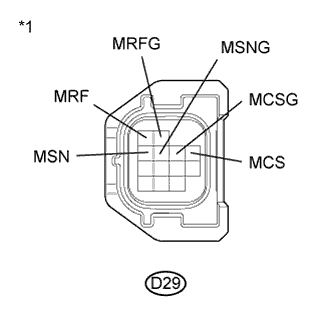 |
Measure the voltage according to the value(s) in the table below.
| Tester Connection | Switch Condition | Specified Condition |
| D29-1 (MRF) - Body ground | Power switch on (IG) | Below 1 V |
| D29-2 (MRFG) - Body ground | Power switch on (IG) | Below 1 V |
| D29-3 (MSN) - Body ground | Power switch on (IG) | Below 1 V |
| D29-4 (MSNG) - Body ground | Power switch on (IG) | Below 1 V |
| D29-6 (MCS) - Body ground | Power switch on (IG) | Below 1 V |
| D29-5 (MCSG) - Body ground | Power switch on (IG) | Below 1 V |
| *1 | Front view of wire harness connector (to Inverter with Converter Assembly) |
Turn the power switch off.
Connect the inverter with converter assembly connector.
|
| ||||
| OK | |
| 10.CHECK MOTOR RESOLVER |
Disconnect the low voltage connector D29 from the inverter with converter assembly.
 |
Measure the resistance according to the value(s) in the table below.
| Tester Connection | Switch Condition | Specified Condition |
| D29-1 (MRF) - D29-2 (MRFG) | Power switch off | 7.1 to 21.6 Ω |
| D29-3 (MSN) - D29-4 (MSNG) | Power switch off | 13.7 to 34.5 Ω |
| D29-6 (MCS) - D29-5 (MCSG) | Power switch off | 12.8 to 32.4 Ω |
| Tester Connection | Switch Condition | Specified Condition |
| D29-1 (MRF) or D29-2 (MRFG) - Body ground and other terminals | Power switch off | 1 MΩ or higher |
| D29-3 (MSN) or D29-4 (MSNG) - Body ground and other terminals | Power switch off | 1 MΩ or higher |
| D29-6 (MCS) or D29-5 (MCSG) - Body ground and other terminals | Power switch off | 1 MΩ or higher |
| *1 | Front view of wire harness connector (to Inverter with Converter Assembly) |
Connect the inverter with converter assembly connector.
|
| ||||
| OK | |
| 11.CHECK INVERTER WITH CONVERTER ASSEMBLY (GENERATOR CABLE CONNECTION CONDITION) |
Check that the service plug grip is not installed.
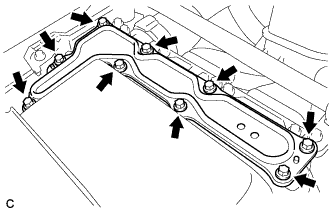 |
Remove the inverter terminal cover from the inverter with converter assembly.
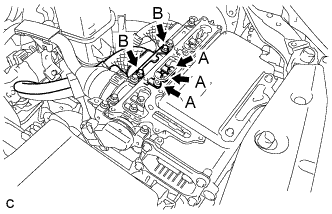 |
Check that the bolts for the generator cable are tightened to the specified torque, the generator cable is connected securely, and there are no contact problems.
Disconnect the generator cable from the inverter with converter assembly.
Check for arc marks at the bolts for the generator cable.
| Result | Proceed to | |
| The terminals are connected securely and there are no contact problems. | There are no arc marks. | A |
| The terminals are not connected securely and there is a contact problem. | There are arc marks. | B |
| The terminals are not connected securely and there is a contact problem. | There are no arc marks. | C |
| The terminals are connected securely and there are no contact problems. | There are arc marks. | B |
Connect the generator cable to the inverter with converter assembly.
Install the inverter terminal cover.
|
| ||||
|
| ||||
| A | |
| 12.CHECK INVERTER WITH CONVERTER ASSEMBLY (MOTOR CABLE CONNECTION CONDITION) |
Check that the service plug grip is not installed.
 |
Remove the inverter terminal cover from the inverter with converter assembly.
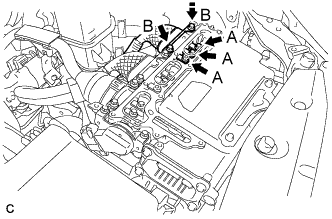 |
Check that the bolts for the motor cable are tightened to the specified torque, the motor cable is connected securely, and there are no contact problems.
Disconnect the motor cable from the inverter with converter assembly.
Check for arc marks at the bolts for the motor cable.
| Result | Proceed to | |
| The terminals are connected securely and there are no contact problems. | There are no arc marks. | A |
| The terminals are not connected securely and there is a contact problem. | There are arc marks. | B |
| The terminals are not connected securely and there is a contact problem. | There are no arc marks. | C |
| The terminals are connected securely and there are no contact problems. | There are arc marks. | B |
Connect the motor cable to the inverter with converter assembly.
Install the inverter terminal cover.
|
| ||||
|
| ||||
| A | |
| 13.CHECK HYBRID VEHICLE TRANSAXLE ASSEMBLY (MG1) |
Check that the service plug grip is not installed.
 |
Remove the inverter terminal cover from the inverter with converter assembly.
Disconnect the generator cable and motor cable from the inverter with converter assembly.
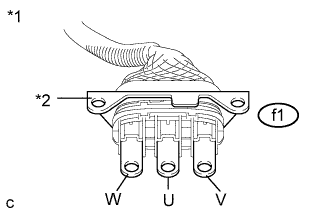 |
Check MG1 for an interphase short using a milliohmmeter.
Using a milliohmmeter, measure the resistance according to the value(s) in the table below.
| Tester Connection | Switch Condition | Specified Condition |
| f1-1 (W) - f1-2 (U) | Power switch off | 89.5 to 98.9mΩ |
| f1-2 (U) - f1-3 (V) | Power switch off | 89.5 to 98.9mΩ |
| f1-3 (V) - f1-1 (W) | Power switch off | 89.5 to 98.9mΩ |
| *1 | Generator Cable |
| *2 | Shield Ground |
Using a megohmmeter set to 500 V, measure the resistance according to the value(s) in the table below.
| Tester Connection | Switch Condition | Specified Condition |
| f1-1 (W) - Body ground and shield ground | Power switch off | 100 MΩ or higher |
| f1-2 (U) - Body ground and shield ground | Power switch off | 100 MΩ or higher |
| f1-3 (V) - Body ground and shield ground | Power switch off | 100 MΩ or higher |
Connect the generator cable and motor cable.
Install the inverter terminal cover.
|
| ||||
| OK | |
| 14.CHECK HYBRID VEHICLE TRANSAXLE ASSEMBLY (MG2) |
Check that the service plug grip is not installed.
 |
Remove the inverter terminal cover from the inverter with converter assembly.
Disconnect the generator cable and motor cable from the inverter with converter assembly.
 |
Check MG2 for an interphase short using a milliohmmeter.
Using a milliohmmeter, measure the resistance according to the value(s) in the table below.
| Tester Connection | Switch Condition | Specified Condition |
| e1-1 (W) - e1-2 (U) | Power switch off | 152.6 to 169.0 mΩ |
| e1-2 (U) - e1-3 (V) | Power switch off | 157.6 to 174.0 mΩ |
| e1-3 (V) - e1-1 (W) | Power switch off | 151.6 to 168.0 mΩ |
| *1 | Motor Cable |
| *2 | Shield Ground |
Using a megohmmeter set to 500 V, measure the resistance according to the value(s) in the table below.
| Tester Connection | Switch Condition | Specified Condition |
| e1-2 (U) - Body ground and shield ground | Power switch off | 100 MΩ or higher |
| e1-3 (V) - Body ground and shield ground | Power switch off | 100 MΩ or higher |
| e1-1 (W) - Body ground and shield ground | Power switch off | 100 MΩ or higher |
Connect the generator cable and motor cable.
Install the inverter terminal cover.
|
| ||||
| OK | |
| 15.CHECK FUSE (PCU) |
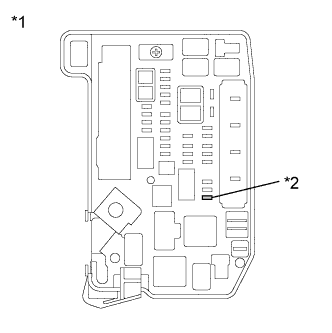 |
Remove the PCU fuse from the engine room junction block assembly.
Measure the resistance according to the value(s) in the table below.
| Tester Connection | Condition | Specified Condition |
| PCU fuse terminal | Always | Below 1Ω |
| *1 | Engine Room Junction Block Assembly |
| *2 | PCU fuse |
Install the PCU fuse.
|
| ||||
| OK | |
| 16.CHECK HARNESS AND CONNECTOR (INVERTER WITH CONVERTER ASSEMBLY POWER SOURCE CIRCUIT) |
Check that the service plug grip is not installed.
Disconnect connector A59 from inverter with converter assembly.
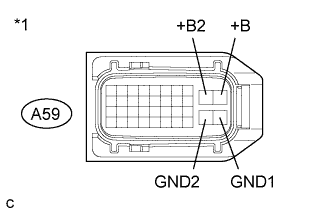 |
Measure the resistance according to the value(s) in the table below.
| Tester Connection | Switch Condition | Specified Condition |
| A59-28 (GND1) - Body ground | Power switch off | Below 1 Ω |
| A59-27 (GND2) - Body ground | Power switch off | Below 1 Ω |
| *1 | Front view of wire harness connector (to Inverter with Converter Assembly) |
Turn the power switch on (IG).
Measure the voltage according to the value(s) in the table below.
| Tester Connection | Switch Condition | Specified Condition |
| A59-10 (+B) - Body ground | Power switch on (IG) | Same as auxiliary battery voltage |
| A59-9 (+B2) - Body ground | Power switch on (IG) | Same as auxiliary battery voltage |
Turn the power switch off.
Connect the inverter with converter assembly connector.
|
| ||||
| OK | |
| 17.CHECK HARNESS AND CONNECTOR (POWER MANAGEMENT CONTROL ECU - INVERTER WITH CONVERTER) |
Check that the service plug grip is not installed.
Turn the power switch off.
Disconnect connector A59 from the inverter with converter assembly.
Disconnect connector A22 from the power management control ECU.
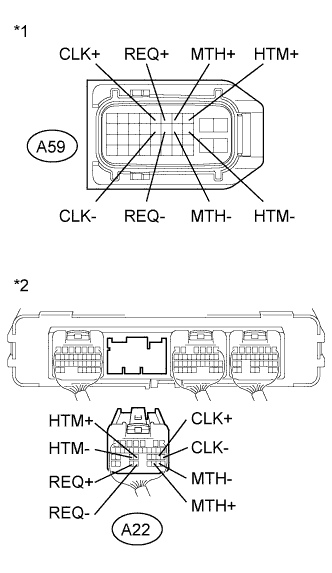 |
Measure the resistance according to the value(s) in the table below.
| Tester Connection | Switch Condition | Specified Condition |
| A22-24 (HTM+) - A59-8 (HTM+) | Power switch off | Below 1 Ω |
| A22-25 (HTM-) - A59-18 (HTM-) | Power switch off | Below 1 Ω |
| A22-30 (MTH+) - A59-7 (MTH+) | Power switch off | Below 1 Ω |
| A22-29 (MTH-) - A59-17 (MTH-) | Power switch off | Below 1 Ω |
| A22-33 (REQ+) - A59-6 (REQ+) | Power switch off | Below 1 Ω |
| A22-32 (REQ-) - A59-16 (REQ-) | Power switch off | Below 1 Ω |
| A22-21 (CLK+) - A59-5 (CLK+) | Power switch off | Below 1 Ω |
| A22-20 (CLK-) - A59-15 (CLK-) | Power switch off | Below 1 Ω |
| Tester Connection | Switch Condition | Specified Condition |
| A22-24 (HTM+) or A59-8 (HTM+) - Body ground and other terminals | Power switch off | 10 kΩ or higher |
| A22-25 (HTM-) or A59-18 (HTM-) - Body ground and other terminals | Power switch off | 10 kΩ or higher |
| A22-30 (MTH+) or A59-7 (MTH+) - Body ground and other terminals | Power switch off | 10 kΩ or higher |
| A22-29 (MTH-) or A59-17 (MTH-) - Body ground and other terminals | Power switch off | 10 kΩ or higher |
| A22-33 (REQ+) or A59-6 (REQ+) - Body ground and other terminals | Power switch off | 10 kΩ or higher |
| A22-32 (REQ-) or A59-16 (REQ-) - Body ground and other terminals | Power switch off | 10 kΩ or higher |
| A22-21 (CLK+) or A59-5 (CLK+) - Body ground and other terminals | Power switch off | 10 kΩ or higher |
| A22-20 (CLK-) or A59-15 (CLK-) - Body ground and other terminals | Power switch off | 10 kΩ or higher |
| *1 | Front view of wire harness connector (to Inverter with Converter Assembly) |
| *2 | Rear view of wire harness connector (to Power Management Control ECU) |
Turn the power switch on (IG).
Measure the voltage according to the value(s) in the table below.
| Tester Connection | Switch Condition | Specified Condition |
| A22-24 (HTM+) or A59-8 (HTM+) - Body ground | Power switch on (IG) | Below 1 V |
| A22-25 (HTM-) or A59-18 (HTM-) - Body ground | Power switch on (IG) | Below 1 V |
| A22-30 (MTH+) or A59-7 (MTH+) - Body ground | Power switch on (IG) | Below 1 V |
| A22-29 (MTH-) or A59-17 (MTH-) - Body ground | Power switch on (IG) | Below 1 V |
| A22-33 (REQ+) or A59-6 (REQ+) - Body ground | Power switch on (IG) | Below 1 V |
| A22-32 (REQ-) or A59-16 (REQ-) - Body ground | Power switch on (IG) | Below 1 V |
| A22-21 (CLK+) or A59-5 (CLK+) - Body ground | Power switch on (IG) | Below 1 V |
| A22-20 (CLK-) or A59-15 (CLK-) - Body ground | Power switch on (IG) | Below 1 V |
Turn the power switch off.
Connect the power management control ECU connector.
Connect the inverter with converter assembly connector.
|
| ||||
| OK | |
| 18.CHECK POWER MANAGEMENT CONTROL ECU |
Disconnect connector A22 from the power management control ECU.
 |
Measure the resistance according to the value(s) in the table below.
| Tester Connection | Switch Condition | Specified Condition |
| A22-24 (HTM+) - A22-25 (HTM-) | Power switch off | 80 to 170 Ω |
| A22-30 (MTH+) - A22-29 (MTH-) | Power switch off | 80 to 170 Ω |
| A22-33 (REQ+) - A22-32 (REQ-) | Power switch off | 80 to 170 Ω |
| A22-21 (CLK+) - A22-20 (CLK-) | Power switch off | 80 to 170 Ω |
| *1 | Component without harness connected (Power Management Control ECU) |
Connect the power management control ECU connector.
|
| ||||
| OK | |
| 19.CHECK CONNECTOR CONNECTION CONDITION (GENERATOR RESOLVER CONNECTOR) |
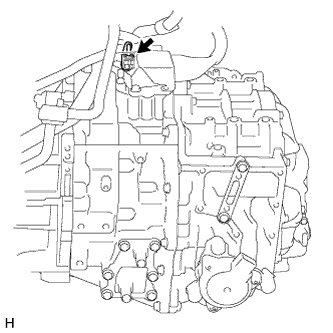 |
Check the connection of the generator resolver connector.
|
| ||||
| OK | |
| 20.CHECK CONNECTOR CONNECTION CONDITION (MOTOR RESOLVER CONNECTOR) |
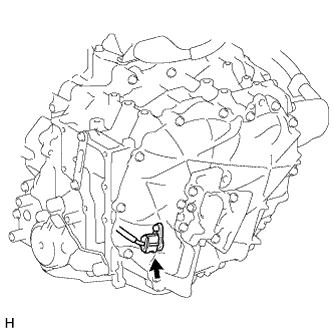 |
Check the connection of the motor resolver connector.
|
| ||||
| OK | ||
| ||
| 21.REPLACE HV COOLANT |
Replace the HV coolant with coolant having an appropriate concentration (appropriate freeze point) for the vehicle usage conditions (Click here).
| NEXT | ||
| ||
| 22.CHECK CONNECTOR CONNECTION CONDITION (GENERATOR RESOLVER CONNECTOR) |
 |
Check the connection of the generator resolver connector.
|
| ||||
| OK | |
| 23.CHECK HARNESS AND CONNECTOR (INVERTER WITH CONVERTER ASSEMBLY - GENERATOR RESOLVER) |
Disconnect the low voltage connector D29 from the inverter with converter assembly.
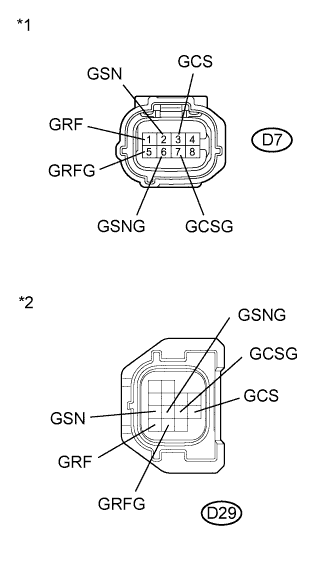 |
Disconnect the generator resolver connector.
Measure the resistance according to the value(s) in the table below.
| Tester Connection | Switch Condition | Specified Condition |
| D7-1 (GRF) - D29-11 (GRF) | Power switch off | Below 1 Ω |
| D7-5 (GRFG) - D29-12 (GRFG) | Power switch off | Below 1 Ω |
| D7-2 (GSN) - D29-7 (GSN) | Power switch off | Below 1 Ω |
| D7-6 (GSNG) - D29-8 (GSNG) | Power switch off | Below 1 Ω |
| D7-3 (GCS) - D29-10 (GCS) | Power switch off | Below 1 Ω |
| D7-7 (GCSG) - D29-9 (GCSG) | Power switch off | Below 1 Ω |
| Tester Connection | Switch Condition | Specified Condition |
| D7-1 (GRF) or D29-11 (GRF) - Body ground and other terminals | Power switch off | 1 MΩ or higher |
| D7-5 (GRFG) or D29-12 (GRFG) - Body ground and other terminals | Power switch off | 1 MΩ or higher |
| D7-2 (GSN) or D29-7 (GSN) - Body ground and other terminals | Power switch off | 1 MΩ or higher |
| D7-6 (GSNG) or D29-8 (GSNG) - Body ground and other terminals | Power switch off | 1 MΩ or higher |
| D7-3 (GCS) or D29-10 (GCS) - Body ground and other terminals | Power switch off | 1 MΩ or higher |
| D7-7 (GCSG) or D29-9 (GCSG) - Body ground and other terminals | Power switch off | 1 MΩ or higher |
| *1 | Front view of wire harness connector (to Generator Resolver) |
| *2 | Front view of wire harness connector (to Inverter with Converter Assembly) |
Connect the generator resolver connector.
Connect the inverter with converter assembly connector.
|
| ||||
| OK | ||
| ||
| 24.CHECK CONNECTOR CONNECTION CONDITION (MOTOR RESOLVER CONNECTOR) |
 |
Check the connection of the motor resolver connector.
|
| ||||
| OK | |
| 25.CHECK HARNESS AND CONNECTOR (INVERTER WITH CONVERTER ASSEMBLY - MOTOR RESOLVER) |
Disconnect the low voltage connector D29 from the inverter with converter assembly.
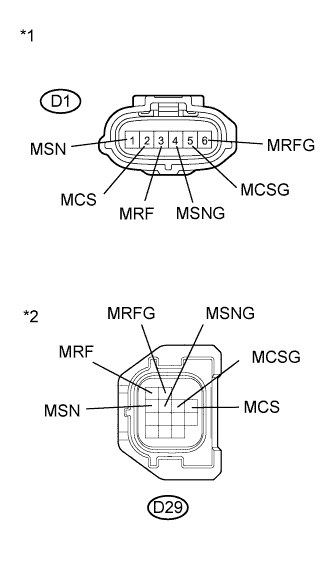 |
Disconnect the motor resolver connector.
Measure the resistance according to the value(s) in the table below.
| Tester Connection | Switch Condition | Specified Condition |
| D1-3 (MRF) - D29-1 (MRF) | Power switch off | Below 1 Ω |
| D1-6 (MRFG) - D29-2 (MRFG) | Power switch off | Below 1 Ω |
| D1-1 (MSN) - D29-3 (MSN) | Power switch off | Below 1 Ω |
| D1-4 (MSNG) - D29-4 (MSNG) | Power switch off | Below 1 Ω |
| D1-2 (MCS) - D29-6 (MCS) | Power switch off | Below 1 Ω |
| D1-5 (MCSG) - D29-5 (MCSG) | Power switch off | Below 1 Ω |
| Tester Connection | Switch Condition | Specified Condition |
| D1-3 (MRF) or D29-1 (MRF) - Body ground and other terminals | Power switch off | 1 MΩ or higher |
| D1-6 (MRFG) or D29-2 (MRFG) - Body ground and other terminals | Power switch off | 1 MΩ or higher |
| D1-1 (MSN) or D29-3 (MSN) - Body ground and other terminals | Power switch off | 1 MΩ or higher |
| D1-4 (MSNG) or D29-4 (MSNG) - Body ground and other terminals | Power switch off | 1 MΩ or higher |
| D1-2 (MCS) or D29-6 (MCS) - Body ground and other terminals | Power switch off | 1 MΩ or higher |
| D1-5 (MCSG) or D29-5 (MCSG) - Body ground and other terminals | Power switch off | 1 MΩ or higher |
| *1 | Front view of wire harness connector (to Motor Resolver) |
| *2 | Front view of wire harness connector (to Inverter with Converter Assembly) |
Connect the motor resolver connector.
Connect the inverter with converter assembly connector.
|
| ||||
| OK | ||
| ||
| 26.CHECK HYBRID VEHICLE TRANSAXLE ASSEMBLY (GENERATOR CABLE CONNECTION CONDITION) |
Check that the service plug grip is not installed.
Remove the inverter with converter assembly.
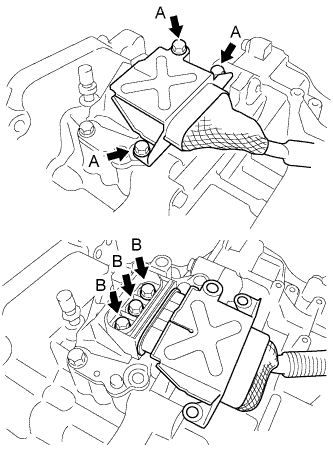 |
Check that the bolts for the generator cable are tightened to the specified torque, the generator cable is connected securely, and there are no contact problems.
Disconnect the generator cable from the hybrid transaxle assembly.
Check for arc marks at the bolts for the generator cable.
| Result | Proceed to | |
| The terminals are connected securely and there are no contact problems. | There are no arc marks. | A |
| The terminals are not connected securely and there is a contact problem. | There are arc marks. | B |
| The terminals are not connected securely and there is a contact problem. | There are no arc marks. | C |
| The terminals are connected securely and there are no contact problems. | There are arc marks. | B |
Connect the generator cable to the hybrid transaxle assembly.
Install the inverter with converter assembly.
|
| ||||
|
| ||||
| A | |
| 27.CHECK GENERATOR CABLE |
Check that the service plug grip is not installed.
Remove the generator cable.
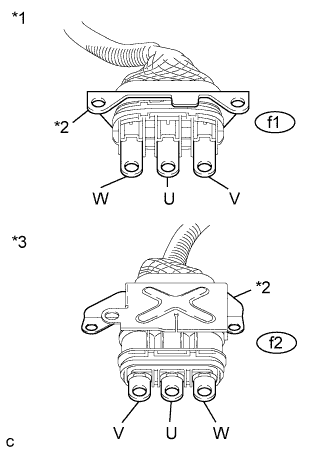 |
Using a megohmmeter set to 500 V, measure the resistance according to the value(s) in the table below.
| Tester Connection | Switch Condition | Specified Condition |
| f1-2 (U) - Body ground and shield ground | Power switch off | 100 MΩ or higher |
| f1-3 (V) - Body ground and shield ground | Power switch off | 100 MΩ or higher |
| f1-1 (W) - Body ground and shield ground | Power switch off | 100 MΩ or higher |
| *1 | Generator Cable (Inverter with Converter Assembly Side) |
| *2 | Shielded ground |
| *3 | Generator Cable (Hybrid Vehicle Transaxle Assembly Side) |
Measure the resistance according to the value(s) in the table below.
| Tester Connection | Switch Condition | Specified Condition |
| f1-2 (U) - f2-2 (U) | Power switch off | Below 1 Ω |
| f1-3 (V) - f2-1 (V) | Power switch off | Below 1 Ω |
| f1-1 (W) - f2-3 (W) | Power switch off | Below 1 Ω |
| f1-2 (U) - f2-1 (V) | Power switch off | 100 MΩ or higher |
| f1-3 (V) - f2-3 (W) | Power switch off | 100 MΩ or higher |
| f1-1 (W) - f2-2 (U) | Power switch off | 100 MΩ or higher |
Install the generator cable.
|
| ||||
| OK | ||
| ||
| 28.CHECK HYBRID VEHICLE TRANSAXLE ASSEMBLY (MOTOR CABLE CONNECTION CONDITION) |
Check that the service plug grip is not installed.
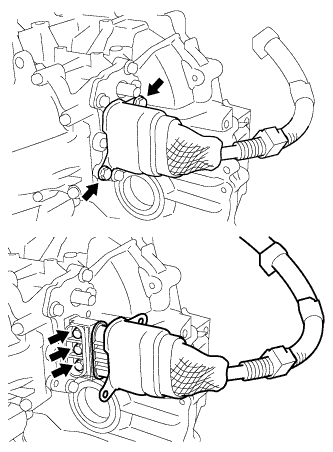 |
Check that the bolts for the motor cable are tightened to the specified torque, the motor cable is connected securely, and there are no contact problems.
Disconnect the motor cable from the hybrid transaxle assembly.
Check for arc marks at the bolts for the motor cable.
| Result | Proceed to | |
| The terminals are connected securely and there are no contact problems. | There are no arc marks. | A |
| The terminals are not connected securely and there is a contact problem. | There are arc marks. | B |
| The terminals are not connected securely and there is a contact problem. | There are no arc marks. | C |
| The terminals are connected securely and there are no contact problems. | There are arc marks. | B |
Connect the motor cable to the hybrid transaxle assembly.
|
| ||||
|
| ||||
| A | |
| 29.CHECK MOTOR CABLE |
Check that the service plug grip is not installed.
Remove the motor cable.
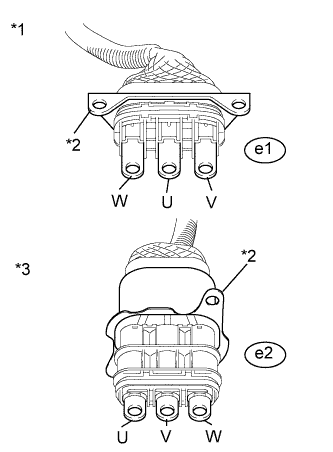 |
Using a megohmmeter set to 500 V, measure the resistance according to the value(s) in the table below.
| Tester Connection | Switch Condition | Specified Condition |
| e1-2 (U) - Body ground and shield ground | Power switch off | 100 MΩ or higher |
| e1-3 (V) - Body ground and shield ground | Power switch off | 100 MΩ or higher |
| e1-1 (W) - Body ground and shield ground | Power switch off | 100 MΩ or higher |
| *1 | Motor Cable (Inverter with Converter Assembly Side) |
| *2 | Shielded ground |
| *3 | Motor Cable (Hybrid Vehicle Transaxle Assembly Side) |
Measure the resistance according to the value(s) in the table below.
| Tester Connection | Switch Condition | Specified Condition |
| e1-2 (U) - e2-3 (U) | Power switch off | Below 1 Ω |
| e1-3 (V) - e2-2 (V) | Power switch off | Below 1 Ω |
| e1-1 (W) - e2-1 (W) | Power switch off | Below 1 Ω |
| e1-2 (U) - e2-2 (V) | Power switch off | 100 MΩ or higher |
| e1-3 (V) - e2-1 (W) | Power switch off | 100 MΩ or higher |
| e1-1 (W) - e2-3 (U) | Power switch off | 100 MΩ or higher |
Install the motor cable.
|
| ||||
| OK | ||
| ||
| 30.CHECK HARNESS AND CONNECTOR (INVERTER WITH CONVERTER ASSEMBLY - PCU FUSE) |
Check that the service plug grip is not installed.
Disconnect connector A59 from the inverter with converter assembly.
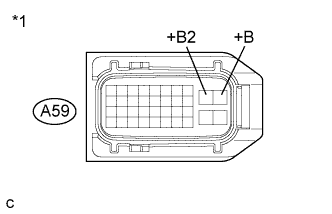 |
Measure the resistance according to the value(s) in the table below.
| Tester Connection | Switch Condition | Specified Condition |
| A59-10 (+B) - Body ground | Power switch off | 10 kΩ or higher |
| A59-9 (+B2) - Body ground | Power switch off | 10 kΩ or higher |
| *1 | Front view of wire harness connector (to Inverter with Converter Assembly) |
Connect the inverter with converter assembly connector.
|
| ||||
| OK | |
| 31.REPLACE INVERTER WITH CONVERTER ASSEMBLY |
Replace the inverter with converter assembly (Click here).
| NEXT | ||
| ||
| 32.REPAIR OR REPLACE HARNESS OR CONNECTOR |
| NEXT | ||
| ||